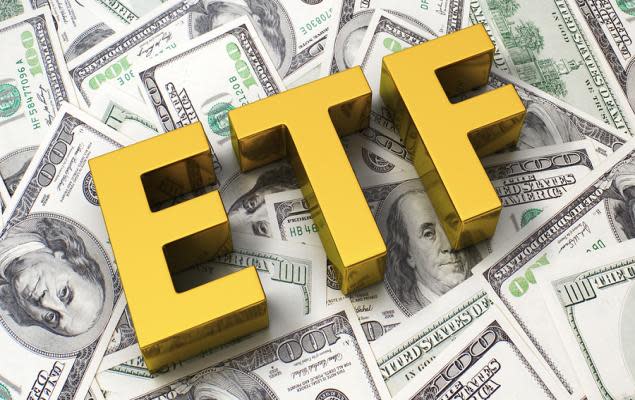ETFs to Buy on Likely March Rate Hike With More in the Cards

The latest Fed meeting came across as hawkish. Federal Reserve policy makers indicated that they are likely to enact their first interest rate hike since 2018 in their March meeting to combat sky-high inflation. “With inflation well above 2 percent and a strong labor market, the Committee expects it will soon be appropriate to raise the target range for the federal funds rate,” the central bank said in a statement that concluded its two-day meeting this week.
Fed Chairman Jerome Powell said asset purchases are also likely to end in March. While officials have not made any plans about when the Fed will start rolling off the nearly $9 trillion in Treasuries and mortgage-backed securities it is holding, statements out of the meeting indicated that the process could begin soon.
Investors had already feared such a move and started to price in a more aggressive schedule this year than what FOMC officials had indicated in their December outlook. At that time, the committee penciled in three 25 basis point moves this year, while the market is pricing in four hikes, according to the CME’s FedWatch tool, as quoted on CNBC. As of Jan 26, 2022, CME’s FedWatch Tool said that there are 32.6% chances of 2022 closing out with 125-150 bps of rates while a 28.1% probability is there for the year to end at 100-125 bps of rates.
The jobs market is nearing full employment. Plus, the bank upped its economic growth projections in its December meeting, raised its inflation outlook and cut unemployment rate projections in its December meeting.
Market Reaction
With the possibility of a hawkish Fed in 2022, government bond yields started rising. At the end of Jan 26, 2022, the yield on the benchmark 10-year Treasury note jumped 7 basis points to 1.85%. The yield on the 30-year Treasury bond was up 4 basis points at 2.16%. The yield on the benchmark 2-year Treasury note surged 11 bps to 1.13%.
Against this backdrop, investors can bet on the following ETFs for current income and likely capital appreciation.
Value – SPDR Portfolio S&P 500 Value ETF SPYV
Rising rates are good for value stocks than the growth ones as the latter’s cash flows come way out in the future. Thus, this group seems less valuable in a rising rate scenario. So, it’s better to go for mature value stocks. These value stocks are cheap \ as they were beaten down amid the peak of the pandemic.
Financials – SPDR S&P Bank ETF KBE
Banks are beneficiaries of rising rates. As banks seek to borrow money at short-term rates and lend at long-term rates, a steepening yield curve earns more on lending and pays less on deposits, thereby leading to a wider spread. This expands net margins and increases banks’ profits. Moreover, an improving economy is always great for banking stocks as these give cues of corporations’ and households’ better financial health. This, in turn, results in lower delinquency rate.
Interest-Hedged High Yield Bonds – ProShares High Yield Interest Rate Hedged HYHG
The underlying FTSE High Yield (Treasury Rate-Hedged) Index comprises long positions in USD-denominated high yield corporate bonds and short positions in U.S. Treasury notes or bonds of approximate equivalent duration. Such a technique of interest-rate hedging makes the fund well-positioned to play in a rising rate environment. The fund charges 51 bps in fees and yields 4.60% annually.
Convertible Bonds – SPDR Bloomberg Barclays Convertible Securities ETF CWB
Convertible bonds are those that can be exchanged if the holder chooses to, for a specific number of preferred or common shares if the company's share price climbs past a said conversion price during the bond's tenure. The fund yields 2.18% annually.
Corporate Bonds – PIMCO Investment Grade Corporate Bond Index ETF CORP
If you really want a fixed-income exposure, investment-grade corporate bonds are great now. The underlying ICE BofAML US Corporate Index is an unmanaged index comprising U.S. dollar denominated investment-grade, fixed-rate corporate debt securities publicly issued in the U.S. domestic market with at least one-year remaining term to final maturity and at least $250 million outstanding. These bonds are highly rated. The fund yields 2.58% annually.
Floating Rate Bonds – iShares Floating Rate Bond ETF FLOT
Floating rate notes are investment grade bonds that do not pay a fixed rate to investors but have variable coupon rates that are often tied to an underlying index (such as LIBOR) plus a variable spread depending on the credit risk of issuers. Since the coupons of these bonds are adjusted periodically, they are less sensitive to an increase in rates compared to traditional bonds.
Want the latest recommendations from Zacks Investment Research? Today, you can download 7 Best Stocks for the Next 30 Days. Click to get this free report
SPDR S&P Bank ETF (KBE): ETF Research Reports
iShares Floating Rate Bond ETF (FLOT): ETF Research Reports
ProShares High YieldInterest Rate Hedged (HYHG): ETF Research Reports
SPDR Portfolio S&P 500 Value ETF (SPYV): ETF Research Reports
SPDR Bloomberg Convertible Securities ETF (CWB): ETF Research Reports
PIMCO Investment Grade Corporate Bond Index ETF (CORP): ETF Research Reports
To read this article on Zacks.com click here.
Zacks Investment Research
